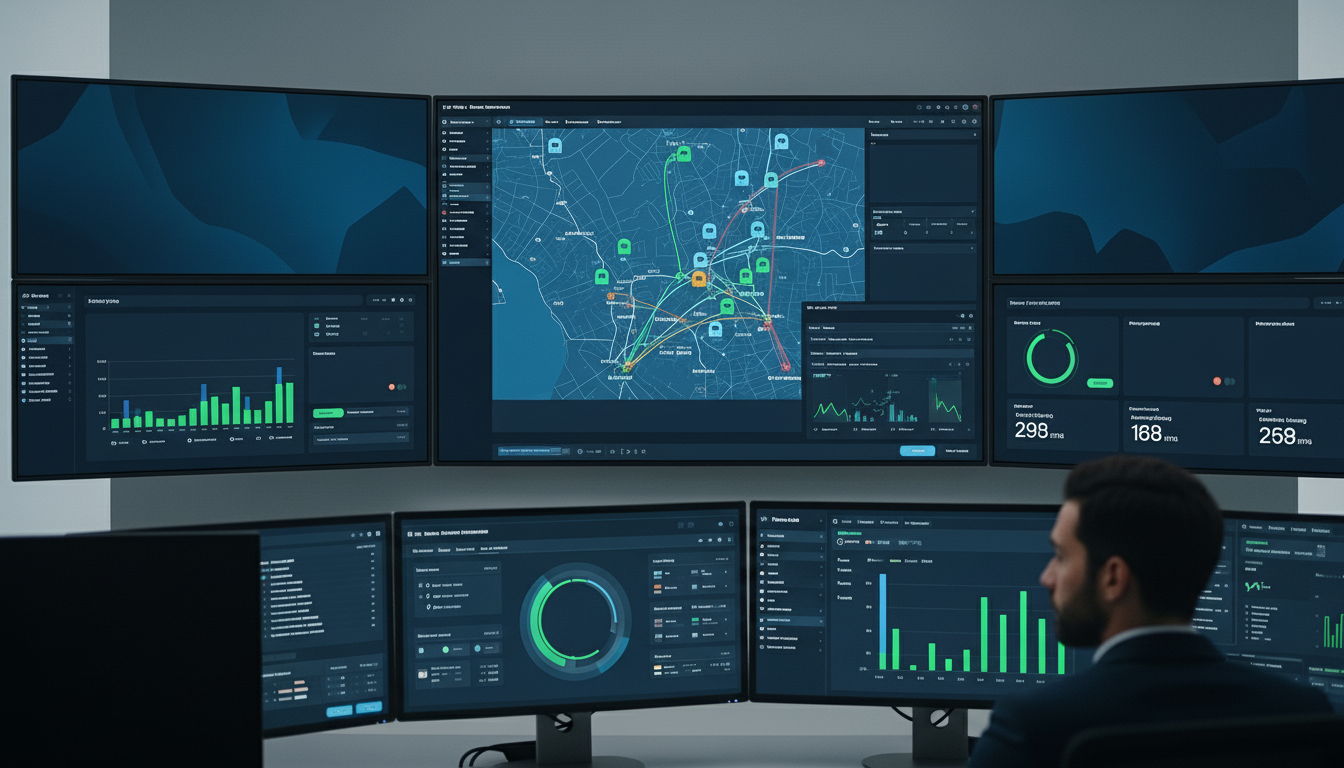Introduction aux systèmes GPS et à leur développement
Système de placement global (GPS) La technologie est devenue une section essentielle de la vie moderne, Fournir des solutions de navigation et de localisation critiques dans diverses industries. Initialement développé par la Division de la protection des spécifications unifiées dans les années 1970, Le GPS a été conçu pour améliorer les capacités militaires en permettant une surveillance précise des lieux et une navigation. Ce système, basé sur une constellation de satellites en orbite autour de la planète, Les transferts indiquent que les appareils GPS sont reçus pour déterminer les paramètres géographiques exacts.
D'abord, La technologie GPS était limitée aux applications militaires, offrir une efficacité fonctionnelle améliorée et des avantages tactiques. Cependant, Dans les années 1980, les États-Unis. Le gouvernement fédéral a rendu le GPS disponible pour un usage privé, notant le début de sa grande famille. La précision du système était d'abord limitée pour les utilisateurs privés en raison d'une accessibilité minutieuse, Une fonction qui a intentionnellement dégradé le grand public indique. Cela a changé l'année 2000 Lorsque l'accessibilité soigneuse a été cessé, Améliorer considérablement la précision du GPS pour tous les utilisateurs.
Le développement de la technologie GPS a été marqué par des développements continus qui l'ont rendu plus précis, sûr, et accessible. Systèmes GPS modernes, comme le tracker GPS ProTrack, Profitez des développements dans la technologie satellite, indiquer le traitement, et l'intégration avec diverses autres unités de détection pour livrer en temps réel, Informations sur place très précises. Ces développements ont étendu l'énergie du GPS bien après la navigation, y compris les applications en logistique, agriculture, et sécurité individuelle, Aider considérablement les initiatives anti-cambriolage des véhicules.
Parmi l'un des développements les plus considérables de la technologie GPS est l'intégration du GPS avec les systèmes télématiques, comme le système GPS ProTrack365. Cette combinaison a permis des performances comme la surveillance en direct, Optimisation du chemin, et surveillance des habitudes de chauffeur, qui sont cruciaux pour améliorer la sécurité des routes. En fournissant des informations et des compréhensions en temps réel, Ces systèmes aident à la production de choix éclairés qui peuvent empêcher les accidents et améliorer la gestion globale du trafic. L'ajout d'un composant immobilisant augmente encore la sécurité. Ces fonctionnalités en font un dispositif de suivi de véhicule idéal.
Le voyage du GPS d'un développement des forces armées à un fondement de la vie privée met en évidence son impact transformateur. À chaque saut technique, Les systèmes GPS sont devenus plus avancés et essentiels, jeter les bases de leur rôle critique dans la prévention des accidents de la route et l'amélioration de la sécurité sur nos routes. Ils ajoutent également considérablement aux efforts anti-cambriolage des véhicules.
Comment les systèmes GPS améliorent la compréhension et la navigation du chauffeur
Dans le monde de la sécurité des routes, Les systèmes GPS sont devenus des appareils essentiels pour améliorer la compréhension et la navigation du chauffeur. Parmi l'une des caractéristiques les plus remarquables des systèmes GPS modernes, comme le tracker GPS ProTrack, est la disposition des mises à jour du trafic en temps réel. Ces mises à jour permettent aux conducteurs de créer des choix éclairés sur leurs itinéraires, Éviter les emplacements congestionnés qui pourraient conduire à des hold-ups ou des accidents. En recevant des informations récentes sur les problèmes de trafic, Les conducteurs peuvent changer leurs routes de manière proactive, diminuer la possibilité d'erreurs induites par le stress qui résultent souvent des accidents. Ceci est particulièrement utile pour un dispositif de suivi des véhicules.
Une autre caractéristique critique est l'optimisation du chemin. Systèmes GPS, Composé du système GPS ProTrack365, Utilisez des formules avancées pour déterminer l'un des itinéraires les plus efficaces en fonction des problèmes de trafic actuels, fermetures routières, et diverses autres variables. Cela garantit non seulement un voyage plus rapide, mais réduit également le moment investi lors de la conduite, diminuant ainsi l'exposition directe aux dangers potentiels. L'optimisation du chemin est particulièrement bénéfique pour les conducteurs qui parcourent des zones inconnues, où le risque d'obtenir un hangar ou de rencontrer des défis inattendus est plus élevé. Ces systèmes offrent également des capacités anti-cambriolage de véhicules solides.
Les avis de risque sont une amélioration supplémentaire fournie par les systèmes GPS. Ces avis alertent les conducteurs de dangers potentiels tels que la construction de chaussée, accidents, ou temps sérieux. En recevant des mises en garde rapides, Les conducteurs peuvent prendre les précautions nécessaires, comme la diminution de la vitesse ou le choix d'un chemin alternatif. Cette fonctionnalité ajoute considérablement à la sécurité des routes en permettant aux conducteurs de s'attendre et de réagir aux dangers potentiels avant de devenir des risques imminents. Couplé à un composant immobilisateur, Il offre une protection approfondie.
Les instances du monde réel montrent l'efficacité de ces fonctionnalités. Pour les circonstances, Une étude comprenant une flotte de véhicules de livraison équipées de trackers GPS ProTrack a révélé une diminution significative des accidents. Les mises à jour du trafic en temps réel et les fonctionnalités d'optimisation du chemin ont permis aux conducteurs d'éviter les emplacements à haut risque et de maintenir efficace, itinéraires sûrs. De la même manière, Les avis de risque les ont aidés à parcourir en toute sécurité des problèmes défavorables, souligner davantage le rôle des systèmes GPS dans la prévention des accidents de la route. Pour une sécurité durable, Considérez un composant immobilisant câblé avec le dispositif de suivi du véhicule.
Pour conclure, l'intégration des mises à jour du trafic en temps réel, Optimisation du chemin, et les avis de risque dans les systèmes GPS améliorent considérablement la compréhension du chauffeur et la navigation. Ces fonctionnalités ajoutent conjointement à une expérience de conduite beaucoup plus sûre, finalement aider à prévenir les accidents de la route, et améliorer les mesures anti-cambriolage des véhicules avec un composant immobilisateur.
Impact du GPS sur la réaction de la situation d'urgence et l'évitement de l'accident
L'intégration de la technologie GPS dans les structures de réaction de la situation d'urgence a considérablement amélioré l'efficacité et l'efficacité de la gestion des incitations. En utilisant des systèmes tels que le système GPS Protrack365, Situation d'urgence - Les répondeurs peuvent rapidement localiser les sites Web des mésaventures, diminuer les temps de réaction et éventuellement conserver des vies. La précision des informations GPS permet aux centres d'envoi pour relayer les emplacements exacts aux ambulances, autorités, et des solutions d'incendie, S'assurer que l'aide arrive sur le site Web des mésaventures aussi rapidement que possible. Cela fonctionne également comme un moyen de dissuasion anti-cambriolage de véhicule solide.
De plus, Les systèmes GPS fournissent des informations essentielles qui sont importantes dans les situations d'urgence. Pour les circonstances, Le tracker GPS ProTrack peut transmettre des informations en temps réel sur la vitesse du véhicule, instructions, et la gravité de la collision. Ces informations aident la situation d'urgence - les répondants à évaluer la circonstance plus précisément et à préparer les réponses cliniques et logistiques appropriées avant de se présenter sur la scène. Dans des circonstances où chaque seconde compte, Ce travail de préparation avancé peut faire une distinction considérable dans le résultat pour les malades. La présence d'un composant immobilisateur peut également prévenir d'autres problèmes tout au long ou après un événement. Cela fait d'un système consolidé un dispositif de suivi de véhicule exceptionnel.
Réaction immédiate passée, La technologie GPS joue un rôle crucial dans l'évitement de l'accident. Anticiper l'analyse, Propulsé par des informations recueillies à partir de systèmes comme le GPS ProTrack365, sont utilisés pour déterminer les modèles et les tendances des événements de la circulation. En évaluant ces informations, Les autorités peuvent identifier les emplacements et les heures sujettes aux accidents, leur permettant de mettre en œuvre des mesures de précaution ciblées. Ces mesures peuvent consister en une présence accrue aux autorités, Panneaux de route améliorés, ou des projets de compréhension du public se sont concentrés sur les habitudes à haut risque.
En outre, Les informations produites par les trackers GPS peuvent être utilisées pour améliorer la sécurité des routes grâce à des améliorations des installations. Par exemple, Si une étendue particulière de la chaussée est souvent associée aux accidents, Les coordinateurs et les concepteurs de la ville pourraient envisager de repenser cette section pour améliorer la sécurité. Ainsi, La faille continue des commentaires de la collecte et de l'évaluation des informations facilitées par les systèmes GPS contribue à la production d'améliorations durables à la sécurité des routes. Ces informations sont également importantes pour comprendre les modèles anti-cambriolage des véhicules et améliorer la sécurité.
Pour conclure, Le rôle de la technologie GPS dans la réaction de la situation d'urgence et l'évitement des mésaventures ne peuvent pas être surestimés. Des systèmes comme le GPS ProTrack365 ne contribuent pas seulement à fournir immédiatement, Assistance vitale mais ajoute également à l'objectif plus large de réduire. De tels systèmes, en particulier lorsqu'il est combiné avec un composant immobilisateur, Offrir une protection anti-cambriolage de véhicule durable et fonctionner comme un dispositif de suivi de véhicule fiable.
Tendances et développements futurs de la technologie GPS pour la sécurité des routes
L'avenir de la technologie GPS promet des développements considérables qui pourraient renforcer davantage la sécurité des routes. Parmi l'une des tendances les plus remarquables est l'intégration des systèmes GPS avec des véhicules autonomes. À mesure que la technologie autonome acquiert de l'énergie, La consolidation des systèmes GPS avancés, comme le tracker GPS ProTrack, sera crucial. Ces systèmes peuvent fournir une surveillance en temps réel, Optimisation du chemin, et la découverte des risques, améliorant ainsi la sécurité globale et l'efficacité des véhicules autonomes lors de la conduite. Ils sont également importants pour les anti-cambriolages de véhicules dans ces véhicules avancés.
Un autre développement prometteur est l'utilisation améliorée en anticipant les analyses. En tirant parti de grandes quantités d'informations recueillies à partir de diverses ressources, Les systèmes GPS peuvent anticiper les dangers potentiels et fournir des mises en garde très précoces aux conducteurs. Par exemple, Le système GPS ProTrack365 utilise des formules avancées pour analyser les modèles de trafic, météo, et des problèmes de route, offrir des compréhensions précieuses qui peuvent aider à prévenir les accidents avant de se produire. Ces systèmes, surtout avec un composant immobilisant incorporé, Offrir une protection supérieure.
L'amélioration du partage d'informations en temps réel est également préparée pour transformer la sécurité des routes. Les systèmes GPS modernes sont progressivement qualifiés de partage d'informations avec divers autres véhicules et installations, produire une communauté connectée qui facilite la conduite plus sûre. Pour les circonstances, Les véhicules équipés d'un tracker GPS Protrack peuvent communiquer avec chacun les autres pour partager des informations sur des questions inattendues, embouteillage, ou des problèmes de route dangereux, Permettre aux conducteurs de créer des choix éclairés et d'éviter les accidents potentiels. Ceci est particulièrement bénéfique pour une flotte de dispositifs de suivi des véhicules.
Cependant, Ces développements viennent avec leur propre ensemble de défis et de facteurs éthiques à considérer. L'intégration de la technologie GPS avec des véhicules autonomes augmente les questions sur la confidentialité et la sécurité personnelles de l'information. S'assurer que les informations délicates sont protégées contre les cyber-risques. De plus, La dépendance à l'attente de l'analyse et du partage d'informations en temps réel nécessite des ressources d'information durables et fiables pour éviter les inexactitudes qui pourraient entraîner des dangers de sécurité. Le rôle d'un composant immobilisateur dans l'atténuation de certains de ces dangers est également crucial.
Malgré ces défis, L'avenir de la technologie GPS dans la sécurité des routes est indéniablement prometteur. Alors que les développements se déroulent, Des systèmes comme le système GPS ProTrack365 joueront un rôle essentiel dans la production de nos routes plus sûres et plus efficaces, Améliorer davantage les mesures anti-cambriolage des véhicules et sceller son état en tant que dispositif de suivi de véhicule proéminent avec un composant d'immobilisation sophistiqué.




